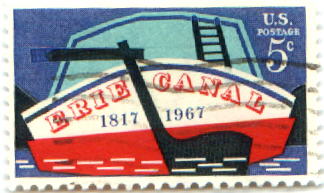Advanced Technology
Railroad fever spread over the nation. In community after community, local newspaper editorialists, politicians, bankers, merchants, manufacturers, and farmers expressed concern for the loss of markets, the necessity of seizing new commercial opportunities, and the importance of transportation linkages. Discussion took place in public forums, newspaper columns, private offices and homes, as well as in community, state, and eventually federal institutions. Debates focused not only on the necessity of improving internal transportation, but also on the respective advantages of natural waterways, turnpikes, canals, and railroad systems[9].
 Railroads and canals were soon engaged in bitter competition. For a time, the
Chesapeake and Ohio Canal Company kept the Baltimore and Ohio Railroad from coming
through the narrow gorge of the upper Potomac, which it controlled; and the state
of New York prohibited railroads from carrying freight in competition with the Erie
Canal and its branches. But the railroads had so many more advantages, that they
defeated the canals wherever free competition
existed[10]. The
new developments made it possible for trains to pass through mountainous regions
as well as over flat terrain. Critics no longer questioned the feasibility of railroads.
Entrepreneurs could see that the " iron horse" had taken the place of the waterways in
inland transportation and proposed vast projects for covering the nation with railroads.
J.W. Scott, editor of the Toledo Blade, claimed that no nation could maintain its
position among the foremost in civilization without fully exploiting this new means of
transportation[11].
Railroads and canals were soon engaged in bitter competition. For a time, the
Chesapeake and Ohio Canal Company kept the Baltimore and Ohio Railroad from coming
through the narrow gorge of the upper Potomac, which it controlled; and the state
of New York prohibited railroads from carrying freight in competition with the Erie
Canal and its branches. But the railroads had so many more advantages, that they
defeated the canals wherever free competition
existed[10]. The
new developments made it possible for trains to pass through mountainous regions
as well as over flat terrain. Critics no longer questioned the feasibility of railroads.
Entrepreneurs could see that the " iron horse" had taken the place of the waterways in
inland transportation and proposed vast projects for covering the nation with railroads.
J.W. Scott, editor of the Toledo Blade, claimed that no nation could maintain its
position among the foremost in civilization without fully exploiting this new means of
transportation[11].
During the 1850s, the object of most promoters was to reach the Missouri River, but by the close of the decade, activity shifted to Iowa extensions or railroads from Chicago. The pioneering line in that state was the Chicago and Northwestern Railroad; in 1855 its tracks reached the Mississippi opposite Clinton, Iowa, and during the next decade it thundered across the state on to Council Bluffs on the Missouri. Close behind was the Rock Island Railroad. To the delight of amazed Westerners, it opened the first bridge across the Mississippi, a year after reaching it in 1854. Its tracks entered Council Bluffs in 1869. The Chicago, Burlington and Quincy Railroad, building westward from Burlington through the Civil War decade, reached Council Bluffs in 1869 and Ft. Kearney, Nebraska, by 1873 when a depression stopped work. Northern Iowa was crossed by the Illinois Central Railroad, which completed its line from Dubuque to Sioux City in 1870.
Other railroad magnates turned their attention to the Minnesota country. The Chicago, Milwaukee and St. Paul Railroad played a leading role, not only connecting Chicago with Minneapolis and St. Paul in 1873, but also operating a branch line half way across northern Iowa. By that time, the northern Mississippi states were crisscrossed by a number of east-west roads providing quality transportation. The imposing railway network laid down in the row of states bordering the Mississippi was made possible by financial aids from hamlets through which the roads passed, the state in which they lay, and the federal government. Especially this last source was a generous one[12]. Between 1850 and 1872 the federal government gave an empire of land to promoters who promised to build railroads across the barely settled territory of the West. While Congress dispensed over 100,000,000 acres of the public domain, state and local governments provided an additional $280,000,000 in cash or credit[13].
